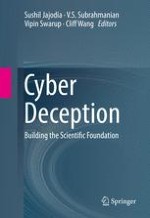
2016 | OriginalPaper | Buchkapitel
Integrating Cyber-D&D into Adversary Modeling for Active Cyber Defense
verfasst von : Frank J. Stech, Kristin E. Heckman, Blake E. Strom
Erschienen in: Cyber Deception
Aktivieren Sie unsere intelligente Suche, um passende Fachinhalte oder Patente zu finden.
Wählen Sie Textabschnitte aus um mit Künstlicher Intelligenz passenden Patente zu finden. powered by
Markieren Sie Textabschnitte, um KI-gestützt weitere passende Inhalte zu finden. powered by